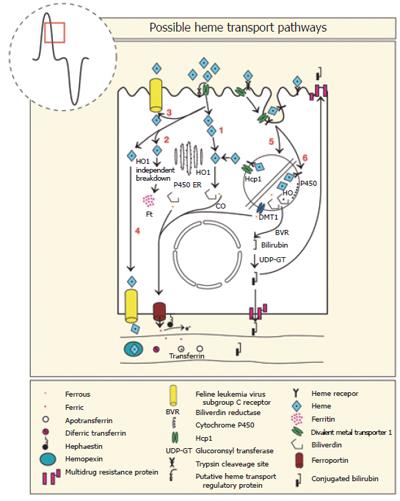Copyright
©2006 Baishideng Publishing Group Co.
World J Gastroenterol. Jul 21, 2006; 12(27): 4281-4295
Published online Jul 21, 2006. doi: 10.3748/wjg.v12.i27.4281
Published online Jul 21, 2006. doi: 10.3748/wjg.v12.i27.4281
Figure 5 Six steps in the uptake of heme by intestinal enterocytes.
Heme taken up by heme carrier protein (HCP1) is internalised and broken down in the cytoplasm by HO-1 (1), by a HO-1 independent enzyme(s) (2), some is released intact back into the lumen (3) or plasma by FLVCR (4). Heme may also bind to a heme receptor and with HCP1 be internalised by receptor mediated endocytosis. The heme may be released to the cytoplasm by HCP1 (5), or the heme may be broken down in the lysosome and the released iron transported to the cytoplasm by the divalent metal transporter (DMT1) (6). The iron released from heme passes to the basal cytoplasm and is transported across the basal membrane by ferroportin in the ferrous state, oxidized to ferric-iron by hephaestin and transported in the plasma by transferrin.
- Citation: Oates PS, West AR. Heme in intestinal epithelial cell turnover, differentiation, detoxification, inflammation, carcinogenesis, absorption and motility. World J Gastroenterol 2006; 12(27): 4281-4295
- URL: https://www.wjgnet.com/1007-9327/full/v12/i27/4281.htm
- DOI: https://dx.doi.org/10.3748/wjg.v12.i27.4281









